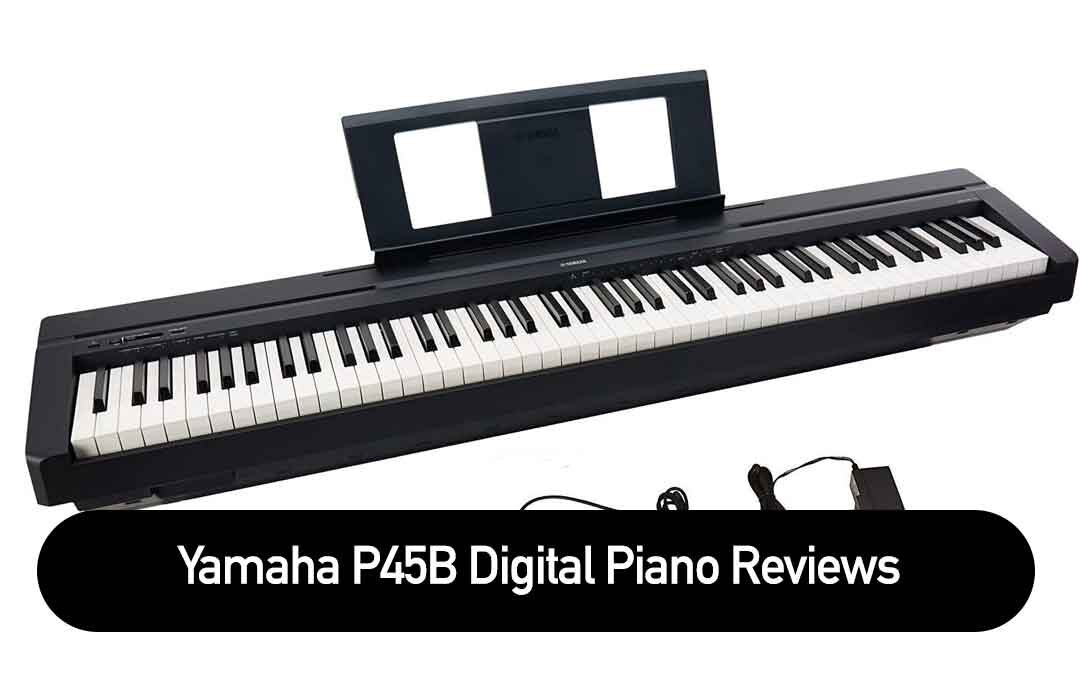Yamaha P45 is one of the best-selling digital pianos from the brand, and that's no surprise.
Many piano teachers worldwide recommend the P45 to their beginner students because it is Yamaha's cheapest 88-key weighted keyboard piano.
But before you invest in the Yamaha P45 digital piano, you must know what you're getting. So you won't get any nasty surprises when you first start playing this instrument.
In this blog post, we'll review the Yamaha P45B digital piano in more in-depth and give our honest opinions on the following areas:
- Key Specifications
- Design
- Keyboard
- Sound Quality
- Features
- Connectivity
- Accessories
- Price
By the end of this post, you'll have all the information you need to decide whether the Yamaha P45 88-key digital piano is right for you.
So, read on to learn everything you need about the Yamaha P45!
Yamaha P45 Digital Piano: An In-Depth Review
Quick Overview
The Yamaha P-45 is the simplest yet most popular model in Yamaha's P (Portable) digital piano series. Also, it's the only digital piano in Yamaha's arsenal that costs less than $600. This makes the P-45 one of the best in its class.
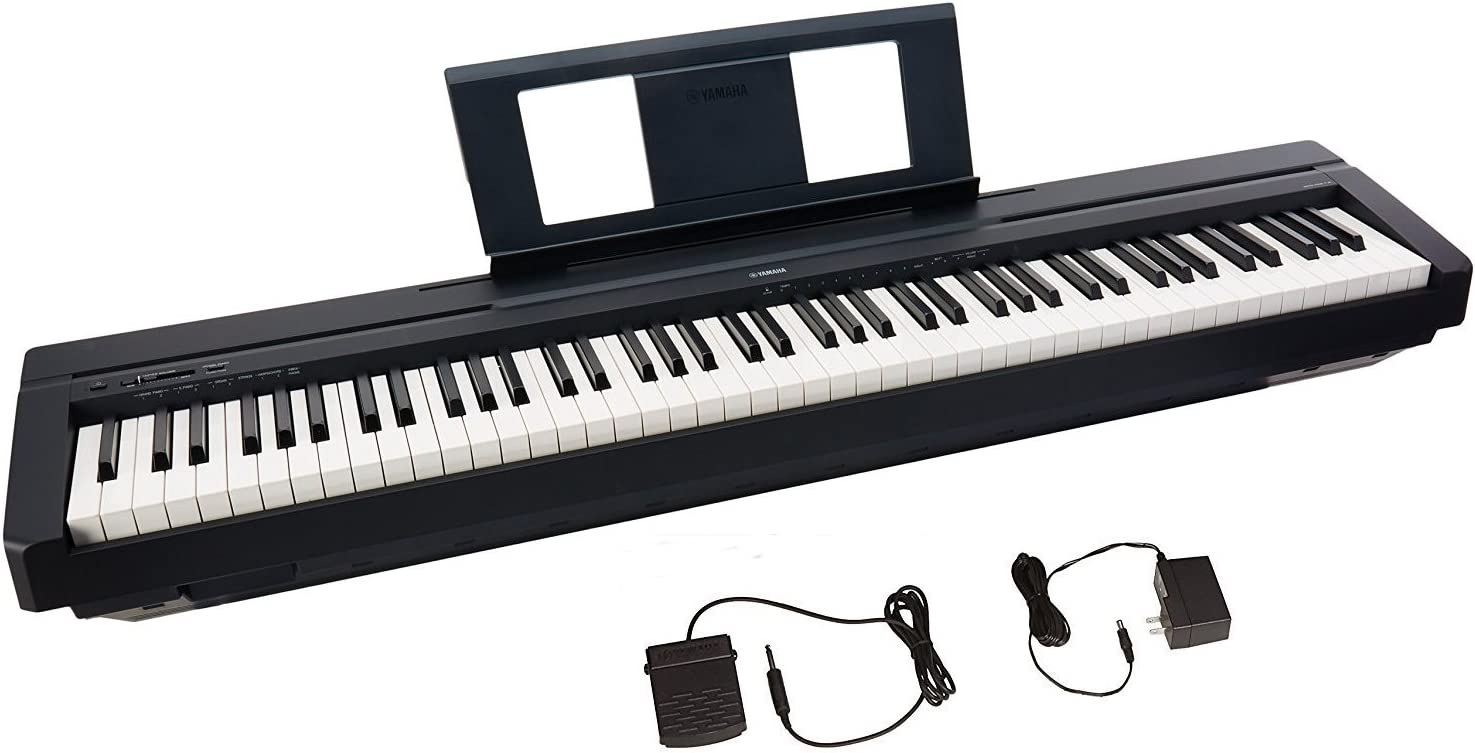
The Yamaha P45 is a fantastic entry-level digital piano for beginners who want to learn how to play the piano without breaking the bank.
It's a compact and lightweight instrument. And you can easily move around, making it perfect for those who want to practice on the go.
The P45 keyboard features 88 fully weighted keys that simulate the feel of an acoustic piano, providing a satisfying playing experience for beginners as well as professional pianists.
Similarly to a traditional piano, the GHS-weighted action is heavier at the low end and lighter at the high end. The keys have a matte finish, which is great for sweaty hands during extended rehearsals.
The Yamaha P45 uses AWM Sampling technology which is excellent and does a good job reproducing the in-built sounds. The P45 contains ten voices, including digitally sampled tones from real Yamaha acoustic grand pianos.
And with the dual mode, you can combine two voices, like piano and strings, for a new and inspiring playing experience. The controls on the P45 are simple and easy to navigate.
Besides that, the package includes a P45 digital piano, power adapter, sustain pedal, and music rest.
Overall, the Yamaha P45 digital piano is a solid choice for beginners looking for an affordable, easy-to-use instrument that provides a quality playing experience. However, it's not the instrument you're looking for if you need many sounds and effects.
Key Specifications
Here are the main specifications of the Yamaha P45 88-Key Weighted Digital Piano:
- Dimensions: 52.2 x 11.6 x 6.0 inches
- Keyboard Type: Graded hammer standard (GHS) keyboard
- No. of Keys: 88
- Touch Sensitivity: Yes (Hard, Medium, Soft, Fixed)
- Piano Sound: AMW Stereo Sampling
- Voices: 10
- Polyphony (Max.): 64
- Demo Songs: 10
- Display: No
- Speakers: 6W + 6W (12cm x 2)
- Effects: Yes
- Metronome: Yes
- Transpose: Yes
- Pedals: 1 (sustain pedal)
- Recorder: N/A
- Modes: Duo & Dual
- Connectivity: USB to Host, Sustain Pedal jack, Headphone jack,
- Power Supply: AC Power Adapter
- Color: Black
- Weight: 11.5kg (25lbs. 4oz)
Design
The Yamaha P45 digital piano has a compact and lightweight design, making it an ideal option for musicians on the go.
Being a portable stage piano, the P45 measures 52 inches in length, 12 inches in depth, and 6 inches in height. The unit weighs 11.5 kg (24 lbs. ), so it is light enough for one person to carry.
If you are traveling or playing gigs, you can conveniently take this keyboard, as it fits in most cars.
In terms of color, it's classic black and white. This model is only available in one color, so you have no choice. The minimalist interface design adds to its aesthetic appeal.
Now let's talk about the controls!
The control panel of the Yamaha P45 is simple and user-friendly. It consists of a power button, volume slide, and function button.
With the function button, you can change the sound, turn on the metronome, and fine-tune the instrument by combining it with one of the 88 piano keys.
However, not all functions are labeled, and you may need to refer to the user manual to adjust some settings like reverb.
The P45 piano doesn't have an LCD screen, so you won't be able to see which instrument sound you choose and other settings you may change, such as reverb, transposition, velocity curve, or the metronome tempo.
However, if you're starting out playing the piano, you probably won't be using these advanced functions yet. So, not having an LCD screen won't be a deal-breaker for beginners.
Overall, the Yamaha P45 portable stage piano is minimalist and easy to use, making it a popular choice for children and adult beginners.
Keyboard
The Yamaha P45 piano keyboard features 88 fully weighted keys with Yamaha's Graded Hammer Standard (GHS) technology. It's the company's most affordable hammer action. You can typically find this hammer action in most entry-level digital pianos.
The keyboard gives the keys a similar feel and action to an acoustic piano, using little hammers inside the keyboard instead of springs (semi-weighted actions).
Like an acoustic piano, the GHS action is heavier at the bottom and lighter at the top.
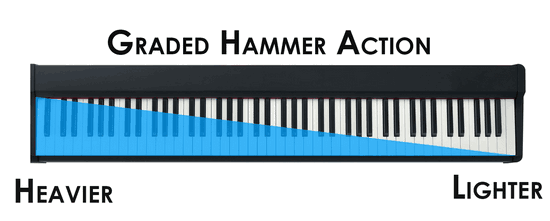
Unlike some high-end models, the P-45 keyboard piano does not have moisture-absorbing keytops that mimic the feel of ivory and ebony.
However, the black keys have a matte finish, which helps prevent fingers from slipping off when moist. The white keys are glossy, which is common in many acoustic pianos.
Note: It's worth mentioning that Yamaha's GHS action tends to be less noisy (noticeable when playing at a low volume or while wearing headphones) than Casio's Tri-sensor hammer action. But in terms of realism, Casio's action is superior.
The keyboard is also touch-sensitive. This means the volume/timbre changes based on how hard or soft you play the piano keys, simulating a grand piano's rich, dynamic range.
You can choose from four different touch-sensitivity levels to suit your playing style: Fixed, Soft, Medium (which is the default), and Hard.
If you select the "Fixed" setting, the keyboard won't change volume based on how hard or soft you play the keys. It will always produce the same amount of sound, no matter how you play.
But if you choose the "Hard" setting, you'll have to hit the keys really hard to get the loudest sound. This gives you the broadest range of sound dynamics.
One downside of the P-45 key action is that it only has two sensors. That makes it harder to play fast repeated notes and control the sound. This is because the key needs to travel a longer distance before making a sound when repeating.
Sound
When it comes to digital pianos, sound quality plays a crucial role. Luckily, the Yamaha P45B digital piano does a great job in this area.
It uses the latest AWM (Advanced Wave Memory) digital technology to capture the authentic sound of a real acoustic piano.
This technology combines pairs of waveforms (L and R) to create a deeper, richer, and more spacious sound. As a result, the P45B piano uses this recorded sound to play at varying volume and timbre levels, making it a versatile instrument.
Additionally, the P-45B offers ten instrument sounds, including:
- Two grand pianos
- Two electric pianos
- Two pipe organs
- Two harpsichords
- A strings section
- And a vibraphone patch.
Beginner and intermediate piano players will find these piano sounds useful for practice and casual playing. You can even layer two voices together to create your own unique sound if you wish.
In addition, the piano has four different reverb effects that you can use to make the sound even better.
The only drawback is that you can't save your customized settings for quick recall.
Other than that, the Yamaha P45B digital piano produces a beautiful piano sound. This instrument is an excellent choice for those looking for an acoustic piano sound in a digital format.
Polyphony
When playing a digital piano, "polyphony" refers to how many notes you can play simultaneously. The more polyphony a piano has, the better it can handle complex music with many notes.
The Yamaha digital piano has 64-note polyphony, which is enough for beginners. This means you can play up to 64 notes simultaneously without any issues. However, 64 notes may not be enough for a professional classical pianist who plays complex pieces. This could lead to notes dropping off and ruining your performance.
So, while the Yamaha digital piano is an excellent option for beginners, it's not the best option for advanced pianists who need more polyphony.
It's worth noting that similarly priced digital pianos from other brands now offer 128 and even 256-note polyphony. You may consider another brand or model if you're an advanced player.
Speakers
The P45 has two built-in speakers that measure 2 x 12 cm and have a 6W + 6W amp. They produce loud enough sound to practice or perform in a small room or in front of a few people.
However, you will need an external amplifier for a live performance with several instruments, as the onboard sound is weak for such occasions.
Considering the size of the P45, the sound quality through its onboard speakers is decent. Even at max volume, the sound remains clear and doesn't distort.
For an even better sound experience, you can plug in a good pair of headphones. It will provide a more precise, detailed sound and immersive listening experience.
Features
The P45B keyboard piano comes with some helpful features that are suitable for beginners as well as intermediate players. Here are some of these features:
Modes
This keyboard piano has two modes:
Dual Mode: This mode lets you layer two instrument sounds so they play together across the entire keyboard range. You can combine different voices (like strings and piano) to create something unique and exciting. Additionally, you can adjust the volume balance between the two sounds to make one louder than the other.
Duo Mode: This mode splits the keyboard into two equal sections with the same pitch range. The instrument allows two people to play at the same time while sitting side by side.
Piano teachers often use this mode to teach their students. The piano teacher can sit next to the student during piano lessons and play some tunes while the student follows along and plays the same notes on the other part of the keyboard. This is a great way to learn together and improve your skills.
Metronome
The P-45 has a built-in metronome that ticks consistently to help you keep a steady tempo. Practicing with a metronome will help you develop time-keeping and rhythmic skills.
You can also adjust the beat, tempo, and volume of the metronome on the P-45 to suit your preferences.
Auto Power Off
The auto-off function saves power by automatically turning off the instrument after 30 minutes of no use. If necessary, you can disable this feature.
Fine-tuning
Even though the P45B doesn't need tuning, it comes with a fine-tuning function. This feature lets you adjust the pitch of the keyboard in small increments (0.2 Hz) to match the pitch of other instruments or singers.
Transpose
The digital piano also has a transpose function that you can use to change the pitch of the keyboard in semitone steps. This makes it easier to play songs in different keys without changing hand placements.
The feature comes in handy if you're playing a song written in a hard key with a lot of black keys. Simply shift the pitch of the keyboard and play the song in an easier key.
All in all, the Yamaha P45B digital piano offers several educational features helpful for piano students looking to start playing piano or improve their skills.
Connectivity
When it comes to connectivity, the Yamaha P45 digital piano offers all the necessary ports and jacks for connecting external devices, such as external amplifiers, headphones, sustain pedals, etc.
You'll find all the connectors on the back of the device.
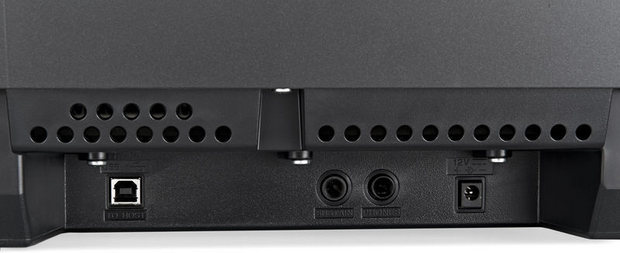
USB (type B) port
The keyboard includes a USB to Host port instead of a Midi In/Out port, which is more convenient in most cases. It allows you to transmit MIDI data to external devices like computers, tablets, etc. You'll need an adapter, though.
To connect the P45 piano to your computer, you'll need an A to B USB cable, which is relatively inexpensive.
Once connected to a computer, you can use the piano keyboard as a MIDI controller with various music software.
Headphone jack
If you want to practice privately or want accurate sound, plug in headphones using the 1/4" stereo jack on the back. Also, this jack lets you connect an external speaker or amplifier to the piano.
Sustain pedal jack
The sustain pedal jack is where you plug in the included footswitch. The jack also works with third-party sustain footswitches/pedals with a 1/4" plug.
Accessories
The Yamaha P-45 digital piano comes with a few useful accessories to get you started with your playing:
- Music Rest
- Basic Sustain Pedal
- AC Power Adapter (with cord)
- Owner's manual
Music Rest
The music rest is designed for portability and is easy to attach and detach from the piano.
Although it doesn't have clips to hold your sheet music, it's big enough to display two and a half A4-sized pages side by side.
Sustain Pedal
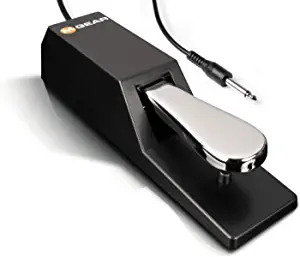
The included Yamaha FC5 sustain footswitch works well, but it looks a bit flimsy and not as elegant as a real piano pedal.
If you want a more realistic experience, consider upgrading to the M-Audio SP-2 piano-style pedal. It is affordable, durable, and feels like a grand piano pedal.
Besides that, you can buy an optional piano-style stand (L-85) to complete the elegant look.
AC Power Adapter
The AC power adapter is included with the piano and comes with a cord. This ensures you can play your piano without worrying about running out of battery.
Owner's manual
The owner's manual is included and will help you get started with your new piano. It covers everything from setting up the piano to troubleshooting common problems.
Price
As we always say, price is one of the most factors when purchasing a product.
Fortunately, the P45B digital piano is an affordable instrument. You can get it on Amazon for about $549, which is reasonable for its quality.
Despite its price tag, this piano is impressive in terms of quality and sound. It has many useful features, especially for beginners learning to play piano.
So, if you're wondering if it's worth the money, the answer is yes. It's worth every penny.
Pros and Cons of The Yamaha P45B Digital Piano
We have discussed the Yamaha P45 digital piano in detail. Now let's summarize its pros and cons:
Pros
Portable design: The P45B piano is lightweight and compact, making it easy to move and store when not in use.
Easy to use: It's simple and easy to use, ideal for beginners who don't want to get bogged down in complex settings.
Good Key Action: Even though the key action is not perfect for professional musicians, it is pretty decent for beginners.
Excellent piano sound: The P45B simulates the sound of an acoustic piano beautifully. It also comes with ten high-quality instrument sounds.
Various connectivity options: This piano has multiple connectivity options, allowing you to connect it to external devices like headphones, amplifiers, and computers. This expands the piano's versatility.
Inexpensive: It is an affordable digital piano that anyone can afford.
Cons
No built-in recording function: The Yamaha P45B doesn't have a built-in recording function, so you'll need to use external devices to record your performances.
Flimsy sustain footswitch: The included sustain pedal is slightly flimsy and doesn't look very nice.
Doesn't include a stand and bench: It doesn't include a keyboard stand and a piano bench, so you'll need to purchase those separately.
Who Should Buy Yamaha P45 Digital Piano?
If you're a beginner piano player looking for your first digital piano at an affordable price to start your musical journey, the Yamaha P45B is your best bet.
It's designed to cater to beginners who want to learn the piano without breaking the bank. It has all the necessary features and a good key action to help you develop your skills during the early stages of learning.
It is also a good choice for those who want to try piano playing but are unsure if it is for them. Since it has an affordable price point, you won't lose much if you decide to give up later.
However, if you're an intermediate or advanced-level player, we cannot recommend the Yamaha P45. Two primary reasons account for this:
Firstly, the limited polyphony of the P45 can make it challenging to play more complex classical pieces. That's because any sound older than the last 64 will be cut off, which can be frustrating for more experienced players.
Secondly, the duo sensor used in the key action of the P45 can make it challenging to play repeated notes quickly and with control, which can also be a significant drawback for intermediate or advanced pianists.
These downsides won't affect beginners. They may become frustrating as you progress and improve your skills. Therefore, it's essential to consider your level and musical goals before purchasing a digital piano, including the Yamaha P45.
Conclusion
I hope this article has helped you determine whether you should get the Yamaha P45B digital piano in 2023.
The P45 model is ideal for beginners since it has all the features a beginner needs without adding unnecessary frills. It's affordable and offers fantastic sound and touch for the price.
But if you're an intermediate player or professional musician, the P45 is not your thing. Instead, I'd suggest looking for other digital pianos, such as the Yamaha P-125, the Casio PX-160, Alesis Recital Pro, and the Korg B1 digital keyboards.
Overall, I strongly recommend the Yamaha P45 to beginners on a budget looking for a quality digital piano for under $600.
Related Topics
- Yamaha Piano For Beginners
- Yamaha YPG-235 76 Key Portable Grand Piano Review
- Yamaha Piano For Beginners
Harlan Kilstein began playing piano during covid with no piano background at all. He taught himself how to play learning what to do and what not to do.
Today he's an advanced intermediate player and can help you grow in your skills because he learned all this on his own.

